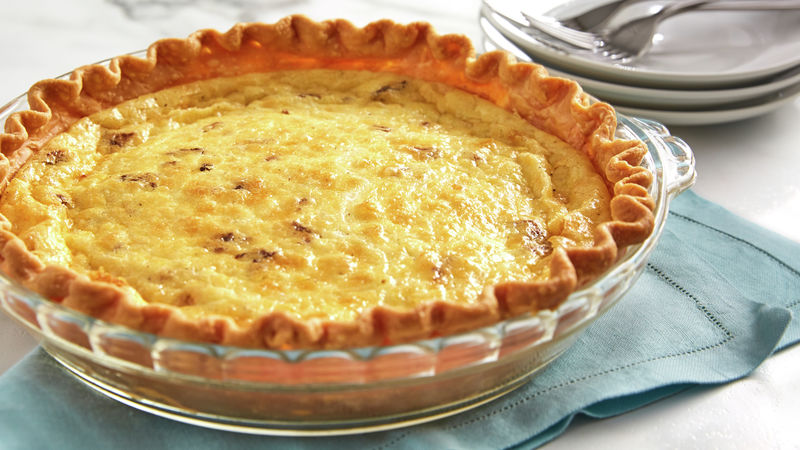Quiche-Eggs in a Pie Crust
TEXARKANA, Ark. –
Quiche is a savory egg custard baked in a flaky pie crust shell. Eggs in a pie crust, what is not to love?
The base of quiche is made of milk, cream, and eggs. You probably have a plethora of ingredients in your refrigerator to add in. The add-ins can include meats, seafood, cheese, spices, and vegetables. Perfect quiche is creamy and soft baked in a pie crust, although crustless quiche is also an option.
If you have the time, make your own pie crust. Any traditional pie crust recipe will work, just omit the sugar if it is in the recipe. If using frozen piecrust choose the deep-dish size.
Avoid a soggy crust by baking it first. As the pie crust bakes, its fat will melt. The melting fat causes the pie crust to shrink down the sides of the pie dish. To keep it from completely losing its shape, weigh it down with pie weights o even dry beans. Line the pie dough with parchment paper first, then pour in pie weights (2 packages will be needed) or even dry beans. To prevent the pie edges from overbaking add a pie shield or aluminum foil wrapped around the crust top. Bake until the edges are lightly brown. Then remove the pie weights and prick the crust with a fork. Bake crust for about 8 more minutes.
Eggs are essential for a quiche. The magic number for a good quiche is 4 eggs when baking it in a nine-inch deep dish pie pan. It may seem like a lot but remember one quiche feeds a lot of people.
Milk is the next essential ingredient. If you have heavy cream, it will add a great dimension to your quiche or substitute half-and-half. If you do not have those, whole milk will work. Other dairy substitutions like sour cream or crème fraiche will be a poor substitute. Beat your eggs and milk or cream, then whisk in your add ins.
When adding filling ingredients, they should be cooked, not raw. Pieces should be cut small and drained well. It is best to pat them dry before using because excess moisture will create a soupy quiche. Some classic filling combinations are Cheddar cheese and ham or sautéed onion or shallots, bacon and Swiss or Gruyere cheese. Shallots are in the same allium family as onions, but they have a deeper flavor with notes of garlic. Spinach, kale, bell pepper, and tomatoes can be fresh. Pour filling into crust and bake until just about set.
Baked custards should be removed from the oven before the center is completely set. The center will jiggle slightly when gently shaken. Custard will continue to cook after it’s removed from the oven and the center will firm up quickly. Overbaked custard may curdle. Test for doneness with a thin-bladed knife. Insert knife about 1 inch from the center of a one-dish custard; midway between center and edge. If knife is clean when pulled out, the custard is done.
If any custard clings to the blade, bake a few minutes longer and test again. Fillings containing cheese may test wet even after they are done. Tap or gently shake the dish; remove quiche from oven when the center is almost set but still jiggles a bit.
If you make extra you can freeze it. Allow baked quiche to cool completely, then cover tightly with aluminum foil and freeze for up to 3 months.
For more information, contact the Miller County Extension Office, 870-779-3609. We're online at cdue@uada.edu, on Facebook and Twitter @MillerCountyFCS or on the web at uaex.uada.edu/Miller.
Bake this Quiche Lorraine with bacon, Swiss cheese and scallions. It will be perfect for your Christmas breakfast. Of course, you can change it up by adding vegetables that you might have on hand.
Quiche Lorraine
- 1 (9 inch) deep dish pie crust, prebaked
- 12 slices bacon
- 1 cup shredded Swiss cheese
- 1/3 cup minced scallions or onion, sauteed
- 4 eggs, beaten
- 2 cups cream or whole milk
- 3/4 teaspoon salt
- 1/4 teaspoon white sugar
- 1/8 teaspoon cayenne pepper
- Preheat oven to 425 degrees F.
- Place bacon in a large skillet, and fry over medium-high heat until crisp.
- Drain on paper towels, then chop coarsely.
- In a medium bowl, whisk together eggs, cream, salt, sugar, and cayenne pepper.
- Add in bacon, cheese, and onion. Mix well.
- Pour mixture into pie shell.
- Bake 15 minutes at 425 degrees.
- Reduce heat to 300 degrees F and bake an additional 30 minutes, or until a knife inserted 1 inch from center comes out clean.
- Allow quiche to sit 10 minutes before cutting into wedges.
By Carla Due
Miller County Extension Agent - FCS
U of A Division of Agriculture
Miller County Cooperative Extension Service
400 Laurel Street, Suite 215 Texarkana AR 71854
(870) 779-3609
cdue@uada.edu
